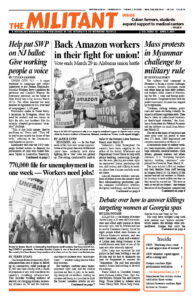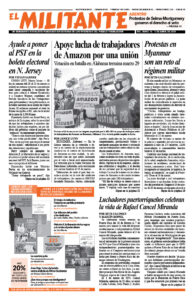Many farmers in Cuba are organizing to donate fresh produce to social institutions as part of the battle by the Cuban people and their revolutionary government against the COVID-19 pandemic and the U.S. rulers’ embargo. It’s a reaffirmation both of the socialist revolution’s principle that no one is left on their own and the determination by Cuban farmers to defend their social, economic and political conquests.
Through the National Association of Small Farmers (ANAP), farmers and farm cooperatives have for decades made regular donations of fruits and vegetables to local hospitals, maternity homes, child care centers and homes serving the elderly. Now, they are expanding that solidarity to patients and staff of COVID-19 isolation and treatment centers, units that have been set up throughout the country since the pandemic began early last year.
“Our cooperative has always distinguished itself by making these donations. Now we’re just increasing it,” farmer Jorge Viera from Camagüey province said as he was unloading crates of vegetables and bunches of plantains. These acts of solidarity are widespread.
Farmers are responding to ANAP’s call to increase food production. This is part of efforts by the revolutionary government and Cuba’s mass organizations to alleviate the financial constraints imposed by Washington’s economic, commercial and financial war against Cuba. These sanctions come on top of shutdowns of production and tourism due to the coronavirus that together sharply reduce access to hard currency necessary for food imports and other supplies.
Founded in May 1961, ANAP is celebrating its 60th anniversary this year. Following the 1959 triumph of the revolutionary struggle led by Fidel Castro and the July 26 Movement, Cuban peasants in their millions drove a land reform that expropriated the capitalist landowners, nationalized the land and turned it over to those who work it. This revolutionary act guaranteed farmers the right to till the land without fear of foreclosure. At the same time, the new workers and farmers government provided low-interest loans, technical assistance and guaranteed prices for their crops. These are all conquests farmers in Cuba continue to use and defend.
Since the beginning of the pandemic, the Cuban leadership has organized to save as many lives as possible. They have dedicated enormous resources and mobilized working people to contain its spread, making Cuba one of the countries with the lowest rate of deaths from COVID-19 in the world. It’s the opposite of what the U.S. capitalist rulers have done, which is based on preserving and relying on their profit-driven system, despite the enormous cost for working people.
As part the battle, Cuban authorities and volunteers from mass organizations do daily house visits to check on everyone’s health. In addition, dozens of special centers have been opened on university campuses where those who may have been exposed to the disease can isolate and get special medical attention.
“My family and I were admitted to an isolation center,” said Edey Suárez, a farmer in Cienfuegos province. “There I was able to appreciate the effort the country is making against the epidemic. I came out with greater determination to find solutions and to contribute,” he said.
No one left on their own
Led by the Union of Young Communists and the Federation of University Students, contingents of students have volunteered to help in the centers. They do everything from house cleaning and laundry to delivering meals to patients in their rooms. They also provide company, explain the testing procedures and help with computer applications that track each patient’s health.
They work alongside medical students who, in turn, are guided by teams of doctors and nurses who visit the patients. When a suspected case turns out positive, the patient is immediately referred to a more specialized facility for early treatment.
One of these centers is at the University of Information Sciences in Havana. The student dormitories there can accommodate 800 people, and the campus medical clinic was rapidly converted into a 170-bed hospital.
“It was an outstanding job,” said Dr. Carlos Alberto Martínez, provincial health director in Havana. “It shows what’s possible when we do what is necessary to protect the health of our people in a battle like the one we’re waging.” The center is staffed by 110 health care workers, who bring the bed-to-worker ratio to less than two — a figure unknown in any hospital in the United States.
The center opened in April last year, around the commemoration of the anniversary of the Cuban people’s victory over the 1961 Bay of Pigs invasion organized by Washington. The counterrevolutionaries were defeated by popular militias and armed forces, dealing a crushing blow to the U.S. rulers and the Cuban landlords and capitalists, who had hoped to reclaim power and take back their former factories and haciendas.
“We come from that same youth. The ideals are the same,” said Silvano Merced, a volunteer, pointing to the example of those who fought against the invasion. He and the others are committed to the battle today in defense of the revolution.
The young volunteers have won the admiration of both the medical personnel and the patients. They treat patients as fellow human beings.
“We don’t have the training the health care staff has. But we have the same humane intentions,” said Yanio Hernández, a professor volunteering at the center along with the students.

